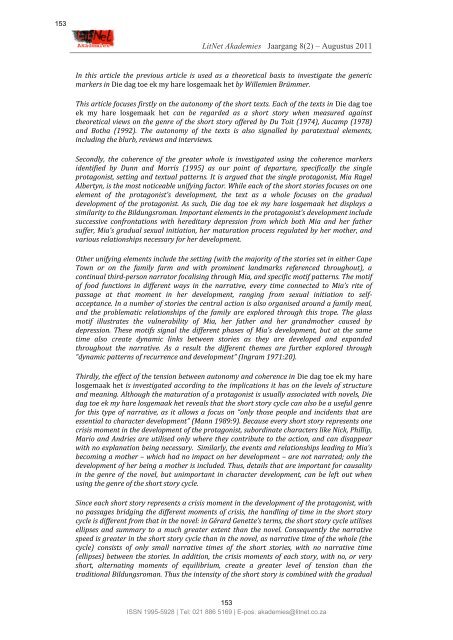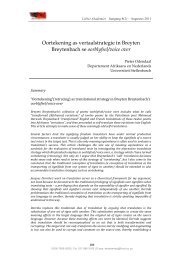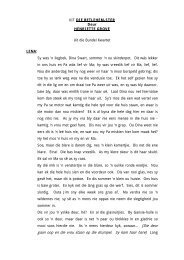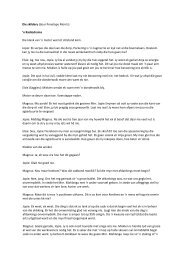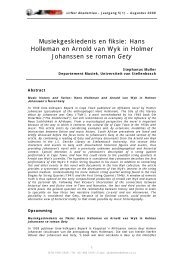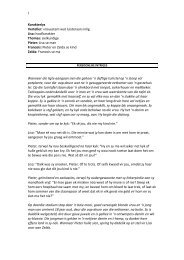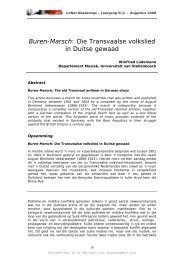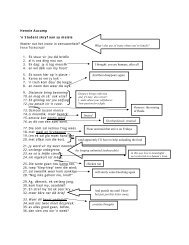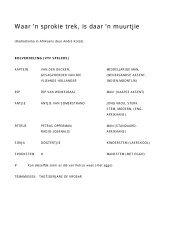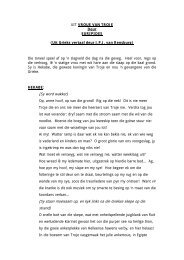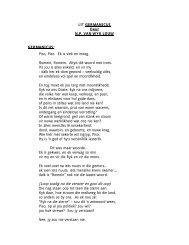Jaargang 8, nommer 2 – Augustus 2011 - LitNet
Jaargang 8, nommer 2 – Augustus 2011 - LitNet
Jaargang 8, nommer 2 – Augustus 2011 - LitNet
Create successful ePaper yourself
Turn your PDF publications into a flip-book with our unique Google optimized e-Paper software.
153<br />
<strong>LitNet</strong> Akademies <strong>Jaargang</strong> 8(2) <strong>–</strong> <strong>Augustus</strong> <strong>2011</strong><br />
In this article the previous article is used as a theoretical basis to investigate the generic<br />
markers in Die dag toe ek my hare losgemaak het by Willemien Brümmer.<br />
This article focuses firstly on the autonomy of the short texts. Each of the texts in Die dag toe<br />
ek my hare losgemaak het can be regarded as a short story when measured against<br />
theoretical views on the genre of the short story offered by Du Toit (1974), Aucamp (1978)<br />
and Botha (1992). The autonomy of the texts is also signalled by paratextual elements,<br />
including the blurb, reviews and interviews.<br />
Secondly, the coherence of the greater whole is investigated using the coherence markers<br />
identified by Dunn and Morris (1995) as our point of departure, specifically the single<br />
protagonist, setting and textual patterns. It is argued that the single protagonist, Mia Ragel<br />
Albertyn, is the most noticeable unifying factor. While each of the short stories focuses on one<br />
element of the protagonist’s development, the text as a whole focuses on the gradual<br />
development of the protagonist. As such, Die dag toe ek my hare losgemaak het displays a<br />
similarity to the Bildungsroman. Important elements in the protagonist’s development include<br />
successive confrontations with hereditary depression from which both Mia and her father<br />
suffer, Mia’s gradual sexual initiation, her maturation process regulated by her mother, and<br />
various relationships necessary for her development.<br />
Other unifying elements include the setting (with the majority of the stories set in either Cape<br />
Town or on the family farm and with prominent landmarks referenced throughout), a<br />
continual third-person narrator focalising through Mia, and specific motif patterns. The motif<br />
of food functions in different ways in the narrative, every time connected to Mia’s rite of<br />
passage at that moment in her development, ranging from sexual initiation to selfacceptance.<br />
In a number of stories the central action is also organised around a family meal,<br />
and the problematic relationships of the family are explored through this trope. The glass<br />
motif illustrates the vulnerability of Mia, her father and her grandmother caused by<br />
depression. These motifs signal the different phases of Mia’s development, but at the same<br />
time also create dynamic links between stories as they are developed and expanded<br />
throughout the narrative. As a result the different themes are further explored through<br />
“dynamic patterns of recurrence and development” (Ingram 1971:20).<br />
Thirdly, the effect of the tension between autonomy and coherence in Die dag toe ek my hare<br />
losgemaak het is investigated according to the implications it has on the levels of structure<br />
and meaning. Although the maturation of a protagonist is usually associated with novels, Die<br />
dag toe ek my hare losgemaak het reveals that the short story cycle can also be a useful genre<br />
for this type of narrative, as it allows a focus on “only those people and incidents that are<br />
essential to character development” (Mann 1989:9). Because every short story represents one<br />
crisis moment in the development of the protagonist, subordinate characters like Nick, Phillip,<br />
Mario and Andries are utilised only where they contribute to the action, and can disappear<br />
with no explanation being necessary. Similarly, the events and relationships leading to Mia’s<br />
becoming a mother <strong>–</strong> which had no impact on her development <strong>–</strong> are not narrated; only the<br />
development of her being a mother is included. Thus, details that are important for causality<br />
in the genre of the novel, but unimportant in character development, can be left out when<br />
using the genre of the short story cycle.<br />
Since each short story represents a crisis moment in the development of the protagonist, with<br />
no passages bridging the different moments of crisis, the handling of time in the short story<br />
cycle is different from that in the novel: in Gérard Genette’s terms, the short story cycle utilises<br />
ellipses and summary to a much greater extent than the novel. Consequently the narrative<br />
speed is greater in the short story cycle than in the novel, as narrative time of the whole (the<br />
cycle) consists of only small narrative times of the short stories, with no narrative time<br />
(ellipses) between the stories. In addition, the crisis moments of each story, with no, or very<br />
short, alternating moments of equilibrium, create a greater level of tension than the<br />
traditional Bildungsroman. Thus the intensity of the short story is combined with the gradual<br />
153<br />
ISSN 1995-5928 | Tel: 021 886 5169 | E-pos: akademies@litnet.co.za


